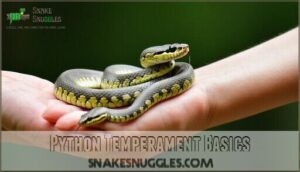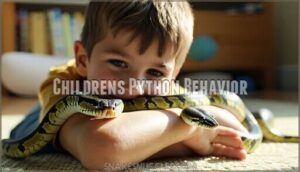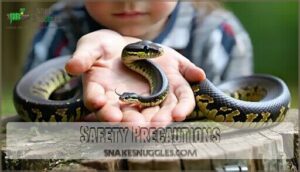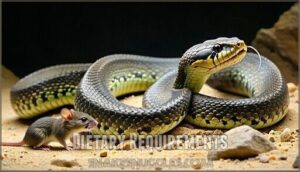This site is supported by our readers. We may earn a commission, at no cost to you, if you purchase through links.

They’re known for their docile nature and rarely bite unless they mistake your hand for food during feeding time.
Most Children’s pythons are curious rather than defensive, making them easy to handle once they’re comfortable with you.
Their peaceful disposition stems from being ambush predators that conserve energy rather than acting aggressively.
While each snake has its own personality – some are more outgoing while others prefer to stay hidden – they generally adapt well to human interaction.
This naturally mellow temperament makes them perfect starter snakes for beginners.
However, understanding the subtle signs of stress and proper handling techniques can make all the difference in building trust with your scaly companion.
Table Of Contents
- Key Takeaways
- Python Temperament Basics
- Childrens Python Behavior
- Python Care and Handling
- Python Health and Wellbeing
- Python Ownership Considerations
- Frequently Asked Questions (FAQs)
- Are children’s pythons friendly?
- What is the temperament of a python snake?
- Are children’s pythons docile?
- Do childrens pythons recognize their owners?
- How often should childrens pythons be fed?
- What substrate works best for childrens pythons?
- Can childrens pythons live with other snakes?
- Do childrens pythons need special lighting requirements?
- Conclusion
Key Takeaways
- You’ll get a naturally calm companion – Children’s pythons are gentle, docile snakes that rarely bite and handle stress well, making them perfect for beginners who want a predictable pet.
- You can build trust through proper handling – Support their body with both hands, limit sessions to 15-20 minutes, 2-3 times weekly, and watch for stress signals like defensive coiling or rapid breathing.
- You’re committing to 20-30 years of care – These snakes live decades and need consistent temperature (78-88°F), humidity (50-60%), proper feeding every 1-2 weeks, and regular vet checkups with exotic specialists.
- You’ll need to research local laws first – Many states require permits or ban pythons entirely, so check with animal control and wildlife agencies before purchasing to avoid fines or confiscation.
Python Temperament Basics
Understanding your children’s python’s temperament starts with recognizing these snakes are generally calm, predictable reptiles that respond well to consistent, gentle handling.
You’ll find that proper interaction techniques and respect for their natural behaviors create the foundation for a trusting relationship with your pet snake, based on consistent handling.
General Python Behavior
Python intelligence shines through their calculated movements and problem-solving abilities.
These serpents display natural behaviors like exploring, basking, and hunting that reflect their wild instincts.
Their communication methods include body language, hissing, and defensive posturing.
Activity patterns typically involve nocturnal exploration and daytime rest, which helps owners recognize normal versus stressed behaviors in their pets, by understanding these child temperament traits, including problem-solving abilities and natural behaviors.
Handling and Interaction
Successful reptile ownership requires understanding proper handling techniques for your Children’s Python.
These docile snakes respond well to gentle handling when approached correctly, making them excellent companions for supervised interactions.
Essential Handling Guidelines:
- Gentle Handling – Support the snake’s body with both hands, moving slowly and deliberately
- Interaction Frequency – Limit sessions to 15-20 minutes, 2-3 times weekly maximum
- Recognizing Stress – Watch for defensive coiling, rapid breathing, or hiding behaviors
- Safe Coexistence – Maintain consistent routines and respect the snake’s natural rhythms
- Child Supervision – Always supervise young handlers, teaching proper techniques first
Python Social Structure
How do these creatures relate to one another?
Unlike many animals, pythons embrace solitary behavior as their natural way of life.
These serpents don’t form social hierarchies or engage in group dynamics found in pack animals.
Python communication occurs through chemical signals and body language, not complex social interactions.
In captivity, cohabitation typically creates stress rather than companionship, making single-housing the preferred approach for their wellbeing.
Childrens Python Behavior
Children’s pythons are renowned for their calm, predictable temperament that makes them excellent beginner snakes.
These gentle giants make perfect first snakes for beginners seeking calm, predictable companions.
You’ll find these Australian natives display consistent docile behavior with proper care, though understanding their environmental needs and occasional defensive responses helps guarantee successful ownership, highlighting the importance of their calm nature.
Docile Nature
Children’s pythons earn their reputation as ideal beginner snakes through their naturally gentle handling characteristics and calm demeanor.
Their docile nature reduces stress for both keeper and pet, creating positive interactions that build confidence in handling techniques.
These docile reptiles rarely show defensive behaviors when properly approached, making them perfect for those new to snake ownership, due to their naturally gentle handling characteristics.
Their scientific name, Antaresia childreni, honors John George Children, showcasing their unique place in the world of snake ownership.
Aggressive Behavior
While generally calm, these snakes can display aggressive behaviors under certain circumstances.
Up to 75% show striking behavior during stress, with juveniles being particularly reactive to handling or environmental changes. As they mature, many owners observe a decrease in this behavior, especially with consistent handling to reduce defensive behavior.
- Biting triggers include food anticipation, improper handling, and enclosure disturbances
- Defensive postures like S-shaped necks and body coiling signal impending strikes
- Stress indicators involve rapid tongue-flicking, elevated posture, and intense staring
- Handling aggression requires calm, deliberate movements and proper timing
- Mitigation strategies focus on regular gentle handling and appropriate environmental conditions
Environmental Factors
Your python’s environment directly shapes its behavior and stress levels.
Temperature gradient between 78-88°F, humidity levels around 50-60%, and proper enclosure size prevent defensive responses.
Inadequate lighting needs, wrong substrate choice, or cramped spaces trigger anxiety.
Like python programming kids learning coding fundamentals, your snake needs consistent conditions to thrive and display its naturally docile temperament, which is achieved through proper enclosure maintenance.
Python Care and Handling
Proper handling of your children’s python requires understanding their calm nature and using supportive techniques that minimize stress.
Creating a secure environment with appropriate temperature, humidity, and hiding spots guarantees your snake remains healthy and comfortable throughout its life.
Proper Handling Techniques
Mastering the art of handling requires patience and technique.
Use a safe approach by supporting your python’s body weight with both hands—one near the head, one mid-body.
Read their signals carefully; tense muscles or defensive posturing mean step back.
Gentle touch builds trust while proper support prevents stress.
For safe handling, consider using specialized reptile gear.
Practice makes perfect.
Safety Precautions
Safety remains paramount when keeping children’s pythons as pets. Always wash your hands before and after handling to maintain proper hygiene practices.
Clean hands before and after handling—your python’s health depends on good hygiene habits.
Create safe enclosures with secure latches to prevent escapes. Establish emergency protocols for handling bites, though rare with these docile snakes.
Guarantee supervised interaction, especially around children, as even gentle pythons can become stressed. Savu pythons, a related species, also benefit from moderate humidity levels to guarantee proper shedding.
Monitor your pet’s behavior closely during each session.
Enclosure and Environment
Your python’s home directly impacts its well-being and behavior.
Create a proper temperature gradient with basking spots at 85-90°F and cool areas around 75-78°F.
Maintain humidity levels between 20-80% using appropriate substrate choices like aspen or bark.
Provide multiple hiding spots and guarantee adequate enclosure size—at least 36"L x 18"W x 18"H for adults to allow natural movement.
The enclosure should also adhere to minimum spatial requirements based on the snake’s length to ensure a healthy environment.
Python Health and Wellbeing
Maintaining your children’s python’s health requires understanding their specific dietary needs and recognizing early signs of illness.
Regular veterinary checkups with an exotic animal specialist will help guarantee your snake lives a long, healthy life in captivity.
Common Health Issues
Watch for respiratory infections, the most common health threat affecting nearly all poorly maintained pythons.
You’ll notice open-mouth breathing, nasal discharge, or wheezing sounds.
Skin problems and shedding issues often stem from incorrect humidity levels, while parasite prevention requires strict quarantine protocols for new additions.
Nutritional deficiencies rarely occur with proper feeding schedules, but maintaining ideal temperatures prevents most complications.
Dietary Requirements
Feeding your children’s python requires careful attention to prey size and feeding frequency.
Offer appropriately sized frozen-thawed rodents every 1-2 weeks for adults, adjusting portions based on your snake’s age and body condition.
Many owners source prey from suppliers for convenience.
Proper hydration methods include providing fresh water bowls, while food variety remains limited to rodents for ideal nutrition, ensuring your snake stays healthy with proper hydration.
Veterinary Care
Finding exotic vets familiar with children’s pythons requires research, as these specialists understand anesthesia risks and proper parasite control.
Schedule annual checkups for preventative care, monitoring for respiratory infections and mites.
Emergency treatment may be needed for injuries or sudden illness.
Infectious stomatitis is one common ailment.
Your python’s docile temperament makes veterinary visits less stressful than with aggressive species.
Python Ownership Considerations
Owning a children’s python requires careful consideration beyond their gentle temperament, as these snakes can live 20-30 years and need consistent care throughout their lifespan.
You’ll need to research local laws regarding snake ownership, prepare for long-term financial commitments including veterinary care, and make certain you can provide proper housing and nutrition for decades to ensure the snake’s well-being and your compliance with regulations, which is a significant long-term commitment.
Responsibility and Commitment
Owning a Children’s Python represents a decades-long commitment requiring careful planning and dedication.
These snakes live 20-30 years, demanding consistent care throughout their lifespan.
Consider these key responsibilities:
- Financial Burden – Budget for enclosure setup, monthly feeding costs, veterinary bills, and equipment replacements over decades
- Long-Term Care – Maintain consistent temperature, humidity, and feeding schedules regardless of life changes or travel plans
- Ethical Considerations – Research reputable breeders who support conservation efforts rather than wild-caught specimens
- Educational Outreach – Learn proper husbandry techniques and stay updated on best practices for responsible snake ownership
Local Regulations and Laws
Before bringing home your children’s python, you’ll need to understand your local exotic pet laws.
Permitting requirements vary substantially between states and cities, with some requiring licenses while others ban pythons entirely. About 20 states require reptile owners to research state laws on snakes before ownership.
| Regulation Type | Common Requirements | Penalties |
|---|---|---|
| Ownership Restrictions | Size limits, species bans | Fines, confiscation |
| Breeding Regulations | Commercial permits, facility inspections | License revocation |
| Sales Restrictions | Documentation, registered dealers | Criminal charges |
| Transport Laws | Interstate permits, CITES paperwork | Federal violations |
Check with your local animal control office and state wildlife agency before purchasing. Even legal ownership often requires escape-proof enclosures and proper documentation.
Long-term Care and Support
Children’s pythons require decades of commitment, making Extended Wellbeing planning essential for both pet and owner.
Like kids coding temperament development, python for shy kids teaches patience and responsibility.
Adaptive Support networks, including exotic veterinarians and reptile communities, facilitate Holistic Development.
Community Integration through reptile clubs provides ongoing guidance, and it’s crucial to consider the Generational Impact—these snakes outlive many pets, requiring children’s python learning about long-term care responsibilities.
Frequently Asked Questions (FAQs)
Are children’s pythons friendly?
Statistics show children’s pythons are kept as pets worldwide due to their small size, docile temperament, strong feeding response.
You’ll find they’re remarkably friendly and gentle companions.
Their gentle temperament makes them ideal for new snake owners, with a strong feeding response.
What is the temperament of a python snake?
Pythons generally have calm, docile temperaments, making them popular pets.
They’re typically non-aggressive toward humans but can be defensive when threatened.
Individual personalities vary, with proper handling creating more relaxed, trusting snakes over time.
Are children’s pythons docile?
Children’s pythons are often kept as pets worldwide due to their docile temperament, making them a perfect choice for beginners.
You’ll find these gentle snakes rarely bite or act aggressively, preferring calm interactions.
They’re tolerant and adaptable creatures that rarely bite or behave aggressively, though each has its own personality.
Do childrens pythons recognize their owners?
Your children’s python likely won’t recognize you as their owner, but they’ll become familiar with your scent and handling routine. They distinguish between familiar and unfamiliar people through chemical cues.
How often should childrens pythons be fed?
You’ll feed juvenile children’s pythons every 5-7 days until they’re adults around two years old, then switch to feeding adults every 10-14 days with properly sized mice or small rats.
What substrate works best for childrens pythons?
Looking at your terrarium floor, you’ll want substrate that retains moisture while preventing mold.
Paper towels offer easy cleaning, while cypress mulch or aspen shavings provide natural burrowing opportunities that children’s pythons love.
Can childrens pythons live with other snakes?
No, you shouldn’t house children’s pythons with other snakes.
They’re naturally solitary creatures that prefer living alone.
Cohabitation creates unnecessary stress, increases disease transmission risk, and can trigger feeding competition or territorial aggression between your pets.
Do childrens pythons need special lighting requirements?
You’ll need UVB lighting for your children’s python, though it’s optional.
Most pythons survive without UVB, but providing it supports natural behaviors and vitamin synthesis.
Essential heat sources maintain proper temperature gradients for healthy digestion.
Conclusion
Like a steady anchor in choppy waters, understanding your children’s python temperament overview provides the foundation for successful snake ownership.
These gentle reptiles reward patient handlers with years of companionship when you respect their natural behaviors.
You’ll discover that proper handling techniques, consistent care routines, and recognizing stress signals create a harmonious relationship.
Remember that each python develops its unique personality over time, and with dedication and knowledge, you’ll enjoy a rewarding experience with your docile scaled companion, based on successful snake ownership.
- https://www.snakeestate.com/pythons/childrens-python/
- https://nickspetneeds.com/2023/08/14/childrens-python-what-you-need-to-know/
- https://www.aussiepythons.com/threads/juvenile-childrens-python-feeding-behaviour.222201/
- https://www.reddit.com/r/snakes/comments/15meb3h/proscons_ball_python_vs_childrens_python/
- https://www.youtube.com/watch?v=Ke4kQ6ehlTE















